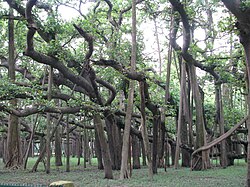Ficus benghalensis: Difference between revisions
>Plantdrew (switch taxobox to speciesbox) |
m (1 revision imported) |
||
| Line 1: | Line 1: | ||
{{ | {{taxobox | ||
|name = Banyan | |name = Banyan | ||
|image = Great banyan tree kol.jpg | |image = Great banyan tree kol.jpg | ||
| Line 6: | Line 5: | ||
|image2= Banyan fruit Ficusbenghalensis IGZoopark Visakhapatnam.JPG | |image2= Banyan fruit Ficusbenghalensis IGZoopark Visakhapatnam.JPG | ||
|image2_caption = Banyan figs at [[Indira Gandhi Zoological Park|Indira Gandhi Zoo Park]], [[Visakhapatnam]] | |image2_caption = Banyan figs at [[Indira Gandhi Zoological Park|Indira Gandhi Zoo Park]], [[Visakhapatnam]] | ||
|genus = Ficus | |regnum = [[Plant]]ae | ||
| | |unranked_divisio = [[Angiosperms]] | ||
|species = benghalensis | |unranked_classis = [[Eudicots]] | ||
| | |unranked_ordo = [[Rosids]] | ||
|ordo = [[Rosales]] | |||
|familia = [[Moraceae]] | |||
|genus = ''[[Ficus]]'' | |||
|subgenus = ''Urostigma'' | |||
|species = '''''Ficus benghalensis''''' | |||
|binomial = ''Ficus benghalensis'' | |||
|binomial_authority = [[Carl Linnaeus|L.]] 1753 | |||
|synonyms = *''Ficus banyana'' <small>Oken </small> | |synonyms = *''Ficus banyana'' <small>Oken </small> | ||
*''Ficus benghalensis var. krishnae'' <small>(C. D. C.) Corner</small> | *''Ficus benghalensis var. krishnae'' <small>(C. D. C.) Corner</small> | ||
| Line 32: | Line 38: | ||
*''Urostigma tjiela'' <small>Miq.</small><ref>[http://www.theplantlist.org/tpl/record/kew-2809652 ''The Plant List'', ''Ficus benghalensis'' Linnaeus].</ref> | *''Urostigma tjiela'' <small>Miq.</small><ref>[http://www.theplantlist.org/tpl/record/kew-2809652 ''The Plant List'', ''Ficus benghalensis'' Linnaeus].</ref> | ||
}} | }} | ||
'''''Ficus benghalensis''''', commonly known as the '''banyan''', '''banyan fig''' and '''Indian banyan''',<ref name=GRIN>{{GRIN | name = ''Ficus benghalensis'' L. | id = 16783 | accessdate = 8 May 2016 }}</ref> is a tree that grows in [[India]] and [[Bangladesh]]. Some Indian banyan trees are among the largest trees in the world. It is recognized as the [[National trees]] of both the countries of the [[Indian subcontinent]]. It is the largest canopy-holder tree of the world. It can spread up to 2000 feet of land. It is said by its scientific name that, this mammoth tree is native and endemic to the Great Bengal Region (both [[Bangladesh]] and [[West Bengal]] of India). In Buddhism the banyan’s habit of supplanting its host tree is likened to the manner in which humans are overcome by sensual desire. Interestingly, the name ‘banyan’ came about when early Portuguese travellers to India noted that traders, or banias, set up shop in the shade of these enormous trees. Eventually the Gujarati word for ‘merchant’ became the name of the tree itself. When traveling in the fascinating country of [[Bangladesh]], be sure to take note of the most unusual banyan tree.<ref name="GRIN">{{GRIN | name = ''Ficus benghalensis'' L. | id = 16783 | accessdate = 8 May 2016 }}</ref> | |||
==References== | |||
{{reflist}} | |||
== | ==Other websites== | ||
{{Commons category|Ficus benghalensis}} | |||
{{Wikispecies|Ficus benghalensis}} | |||
[[Category:Plants of Asia]] | |||
[[Category:National symbols of India]] | |||
[[Category:National symbols of Bangladesh]] | |||
{{biology-stub}} | |||
Revision as of 00:21, 23 April 2021
| Banyan | |
|---|---|

| |
| The Great Banyan in Howrah, Kolkata | |

| |
| Banyan figs at Indira Gandhi Zoo Park, Visakhapatnam | |
| Scientific classification | |
| Kingdom: | |
| (unranked): | |
| (unranked): | |
| (unranked): | |
| Order: | |
| Family: | |
| Genus: | |
| Subgenus: | Urostigma
|
| Species: | Ficus benghalensis
|
| Binomial name | |
| Ficus benghalensis L. 1753
| |
| Synonyms | |
| |
Ficus benghalensis, commonly known as the banyan, banyan fig and Indian banyan,[2] is a tree that grows in India and Bangladesh. Some Indian banyan trees are among the largest trees in the world. It is recognized as the National trees of both the countries of the Indian subcontinent. It is the largest canopy-holder tree of the world. It can spread up to 2000 feet of land. It is said by its scientific name that, this mammoth tree is native and endemic to the Great Bengal Region (both Bangladesh and West Bengal of India). In Buddhism the banyan’s habit of supplanting its host tree is likened to the manner in which humans are overcome by sensual desire. Interestingly, the name ‘banyan’ came about when early Portuguese travellers to India noted that traders, or banias, set up shop in the shade of these enormous trees. Eventually the Gujarati word for ‘merchant’ became the name of the tree itself. When traveling in the fascinating country of Bangladesh, be sure to take note of the most unusual banyan tree.[2]
References
- ↑ The Plant List, Ficus benghalensis Linnaeus.
- ↑ 2.0 2.1 "Ficus benghalensis L." Germplasm Resources Information Network (GRIN). Agricultural Research Service (ARS), United States Department of Agriculture (USDA). Retrieved 8 May 2016.
Other websites